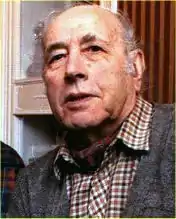Paul Ashbee
Paul Ashbee (23 June 1918 – 19 August 2009) was a leading British archaeologist, noted for his many excavations of barrows, or burial mounds, and for co-directing the Sutton Hoo digs (with Rupert Bruce-Mitford) from 1964 to 1972; he was perhaps less well known as president of the Just William Society. He died of cancer on 19 August 2009, aged 91.[1]
Paul Ashbee | |
|---|---|
 | |
| Born | 23 June 1918 |
| Died | 19 August 2009 (aged 91) |
| Citizenship | British |
| Alma mater | University of London |
| Known for | Leading authority on Neolithic and Bronze Age barrows |
| Scientific career | |
| Fields | Archaeology |
Personal life
The only child of cabinet maker Lewis Ashbee and Hannah Mary Elisabeth, daughter of house decorator William Edward Birch Brett, of Thanet, Kent,[2] Paul Ashbee was born in Bearsted, near Maidstone, Kent. He made national headlines when he uncovered the remains of a Roman villa on a farm at Thurnham when still a teenager.[1] He joined the Royal West Kent Regiment for the duration of the war, followed by the Control Commission for Germany. Although without any qualifications he studied for a diploma in European prehistoric archaeology at the University of London in 1952, followed by a diploma in education at Bristol University and a MA at Leicester University. He became an assistant history master at Britain's first comprehensive school, Forest Hill School, Forest Hill, London where he stayed until 1966.[1] He married Richmal Disher in 1952; the niece and literary executor of Richmal Crompton,[3][4][5] she was a history student and they met at a dig at Verulamium, St Albans in 1949. She died in 2005,[1] after which Ashbee became president of the Just William Society.[4]
Archaeology
Ashbee went into archaeology (during school holidays) after service in the army through the Second World War. He excavated widely across southern Britain and is best known as a leading authority on Neolithic and Bronze Age barrows.[6] From 1976 to 1980 he was the President of the Cornwall Archaeology Society,[7] and was also a commissioner of the Royal Commission on the Historical Monuments of England for 10 years.[1]
Excavations
- 1949–50 — cemetery at Porthcressa, St Mary's, Isles of Scilly
- 1950–52 — assistant to Rupert Bruce-Mitford on the early medieval settlement at Mawgan Porth
- 1955 — barrow at Tregulland, north-east of Bodmin Moor
- 1960 — barrow at Wilsford, Normanton Down, Wiltshire
- 1964–71 — co-director with Rupert Bruce-Mitford at Sutton Hoo
- 1970–? — replacement of the capstones of the entrance grave at Bant's Carn and the multi-period settlement at Halangy, St Mary's, Isles of Scilly
Published work
- Ashbee, Paul (October–November 1954). "Excavation of the Great Barrow at Bishop's Waltham: Possible Burial of a Chief". The Archaeological News Letter. Linden Publicity. 5 (6): 109–110.CS1 maint: ref=harv (link)
- Ashbee, Paul; Ashbee, Richmal C. L. (December 1954). "Excavation of a Barrow at Hindlow". The Archaeological News Letter. Linden Publicity. 5 (7): 134–135.CS1 maint: ref=harv (link)
- 1960 The Bronze Age Round Barrow in Britain, Littlehampton Book Services Ltd, ISBN 978-0460076173
- 1970 The Earthen Long Barrow in Britain, University of Toronto Press, ISBN 978-0802015723
- 1974 Ancient Scilly, David & Charles, ISBN 978-0715365687
- 1978 The Ancient British, Geo Abstracts, ISBN 978-0860940142
- 1996 Halangy Down, St Mary's, Isles of Scilly, Excavations 1964–1977, Cornish Archaeology No 35
- 2005 Kent in Prehistoric Times, The History Press, ISBN 978-0752431369
References
- "Paul Ashbee". The Telegraph (9 October 2009). Retrieved 5 June 2014.
- The Strange Story of Sarah Kelly, Vera Hughes, 1997, p. 67, 193
- "Paul Ashbee". 9 October 2009 – via www.telegraph.co.uk.
- Quinnell, Henrietta (5 October 2009). "Obituary – Paul Ashbee, archaeologist". The Guardian.
- "Letter: Paul Ashbee obituary". The Guardian. 20 October 2009.
- Quinnell, Henrietta (February 2010). "Paul Ashbee 1918–2009" (PDF). Cornish Archaeological Society Newsletter (122): 2. Archived from the original (PDF) on 28 July 2014. Retrieved 5 June 2014.
- Cornish Archaeological Society (October 2009). "Paul Ashbee 1918–2009". Cornish Archaeological Society. 48–49: 325.
- Ward, Anthony; Lawson, Terence (2010). "Paul Ashbee, M.A., D.Litt., F.S.A." (PDF). Archaeologia Cantiana. 130: 435–438.CS1 maint: ref=harv (link)